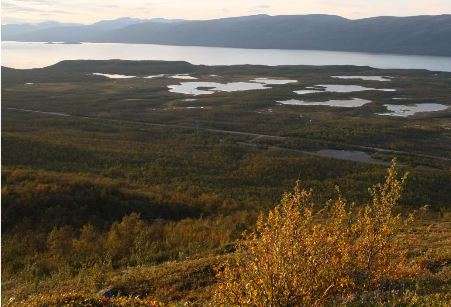Arctic inland waters emit large amounts of carbon

Geoscientist Erik Lundin shows in his thesis that streams and lakes of Northern Sweden are hotspots for emissions of carbon dioxide and methane into the atmosphere. Erik defends his findings at Sweden's Umea University on Friday, January 31.
"Especially small streams, which in this study accounted for only about four percent of the investigated water systems, turned out to be particularly important by releasing about ten times as much carbon as lakes," says Erik Lundin. "The reason for this is that streams generally have high concentrations of carbon dioxide, but also because they are turbulent which promotes exchange of gases with the atmosphere."
One of the greatest challenges of our time is to understand the effects of future climate change and its underlying causes. This requires more knowledge of the global carbon cycle, but also how it is affected by a changing climate.
Erik Lundin shows in his study that lakes release a large portion of their carbon dioxide and methane in connection with thaw. It is partly because organic materials that decompose in the lakes in the winter form dissolved carbon dioxide and methane which is then trapped under the ice. When the ice breaks up in the spring these dissolved gases are released, sometimes as quickly as within a few days.
The study also shows that two thirds of catchment carbon loss is through lakes and streams, either through emissions into the atmosphere, but also as dissolved organic and inorganic carbon, which are transported by rivers downstream.
The field study started from the Abisko Scientific Research Station and was conducted in the area around Abisko.
Although the lakes emit carbon into the atmosphere, carbon is also captured and long-term stored in thick layers of sediment at the lake floors through the accumulation of organic material. Erik Lundin made a detailed study on lake emissions relative to the accumulation of carbon by comparing six arctic lakes with literature data.
The results shows that Arctic lakes are more efficient carbon sequestrators than warmer boreal lakes. It indicates that with a warmer climate northern lakes will reduce their coal storage ability and we can expect larger emissions of carbon dioxide and methane from our northernmost lakes.
Although it has long been known that inland waters are atmospheric sources of carbon dioxide and methane, as well as burying carbon in sediments, they are often overlooked in regional carbon budgets. These budgets are estimated to be able to make good estimates of the amount of carbon in various geographical areas, to show existing quantities as well as changes over time.
What is the practical significance of your results?
"It can be concluded that by ignoring the inland waters in regional carbon budgets, one overestimates the landscape carbon sequestration. This knowledge is important when making predictions of the future climate, but also for estimating the climate's feedback effects on the carbon cycle, " says Erik Lundin.
Provided by Umea University
















